BANANA
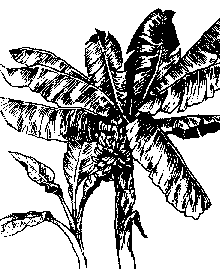
Musa species
Musaceae
Common Names: Banana, Bananier Nain, Canbur, Curro, Plantain
Origin: Edible bananas originated in the Indo-Malaysian region reaching to northern Australia.
Species: Musa acuminata Colla, M. X paradisiaca L. (hybrid)
Related species Abyssinian Banana (Ensete ventricossum Cheesman), Musa balbisina Colla, M. ornata Roxb., M. textilis Nee
Adaptation Bananas and plantains are today grown in every humid tropical region and constitutes the 4th largest fruit crop of the world. The plant needs 10 – 15 months of frost-free conditions to produce a flower stalk. All but the hardiest varieties stop growing when the temperature drops below 53° F. Growth of the plant begins to slow down at about 80° F and stop entirely when the temperature reaches 100° F. High temperatures and bright sunlight will also scorch leaves and fruit, although bananas grow best in full sun. Freezing temperatures will kill the foliage. In most areas bananas require wind protection for best appearance and maximum yield. They are also susceptible to being blown over. Bananas, especially dwarf varieties, make good container specimens if given careful attention. The plant will also need periodic repotting as the old plant dies back and new plants develop.
DESCRIPTION
Growth Habit: Bananas are fast-growing herbaceous perennials arising from underground rhizomes. The fleshy stalks or pseudostems formed by upright concentric layers of leaf sheaths constitute the functional trunks. The true stem begins as an underground corm which grows upwards, pushing its way out through the center of the stalk 10-15 months after planting, eventually producing the terminal inflorescence which will later bear the fruit. Each stalk produces one huge flower cluster and then dies. New stalks then grow from the rhizome. Banana plants are extremely decorative, ranking next to palm trees for the tropical feeling they lend to the landscape.
Foliage: The large oblong or elliptic leaf blades are extensions of the sheaths of the pseudostem and are joined to them by fleshy, deeply grooved, short petioles. The leaves unfurl, as the plant grows, at the rate of one per week in warm weather, and extend upward and outward , becoming as much as 9 feet long and 2 feet wide. They may be entirely green, green with maroon splotches, or green on the upper side and red-purple beneath. The leaf veins run from the mid-rib straight to the outer edge of the leaf. Even when the wind shreds the leaf, the veins are still able to function. Approximately 44 leaves will appear before the inflorescence.
Flowers: The banana inflorescence shooting out from the heart in the tip of the stem, is at first a large, long-oval, tapering, purple-clad bud. As it opens, the slim, nectar-rich, tubular, toothed, white flowers appear. They are clustered in whorled double rows along the the floral stalk, each cluster covered by a thick, waxy, hood like bract, purple outside and deep red within. The flowers occupying the first 5 – 15 rows are female. As the rachis of the inflorescence continues to elongate, sterile flowers with abortive male and female parts appear, followed by normal staminate ones with abortive ovaries. The two latter flower types eventually drop in most edible bananas.
Fruits: The ovaries contained in the first (female) flowers grow rapidly, developing parthenocarpically (without pollination) into clusters of fruits, called hands. The number of hands varies with the species and variety. The fruit (technically a berry) turns from deep green to yellow or red, and may range from 2-1/2 to 12 inches in length and 3/4 to 2 inches in width. The flesh, ivory-white to yellow or salmon-yellow, may be firm, astringent, even gummy with latex when unripe, turning tender and slippery, or soft and mellow or rather dry and mealy or starchy when ripe. The flavor may be mild and sweet or subacid with a distinct apple tone. The common cultivated types are generally seedless with just vestiges of ovules visible as brown specks. Occasionally, cross-pollination with wild types will result in a number of seeds in a normally seedless variety.
CULTURE
Location: Bananas require as much warmth as can be given them. Additional warmth can be given by planting next to a building. Planting next to cement or asphalt walks or driveways also helps. Wind protection is advisable, not for leaf protection as much as for protection of the plant after the banana stalk has appeared. During these last few months propping should be done to keep the plant from tipping or being blown over.
Soil: Bananas will grow in most soils, but to thrive, they should be planted in a rich, well-drained soil. The best possible location would be above an abandoned compost heap. They prefer an acid soil with a pH between 5.5 and 6.5. The banana is not tolerant of salty soils.
Irrigation: The large leaves of bananas use a great deal of water. Regular deep watering is an absolute necessity during warm weather. Do not let plants dry out, but do not overwater. Standing water, especially in cool weather, will cause root rot. Plants grown in dry summer areas such as Southern California need periodic deep waterings to help leach the soil of salts. Spread a thick layer of mulch on the soil to help conserve moisture and protect the shallow roots. Container grown plants should be closely watched to see that they do not dry out. An occasional deep watering to leach the soil is also helpful.
Fertilization: Their rapid growth rate make bananas heavy feeders. During warm weather, apply a balanced fertilizer once a month–a 8:10:8 NPK fertilizer appears to be adequate. A mature plant may require as much as 1-1/2 to 2 pounds of the above fertilizer each month. Young plants need a quarter to a third as much. Spread the fertilizer evenly around the plant in a circle extending 4 – 8 feet from the trunk. Do not allow the fertilizer to come in contact with the trunk. Feed container container plants on the same monthly schedule using about half the rate for outside plants.
Frost Protection: Bananas flourish best under uniformly warm conditions but can survive 28° F for short periods. If the temperature does not fall below 22° F and the cold period is short, the underground rhizome will usually survive. To keep the plants that are above ground producing, protection against low temperatures is very important. Wrap trunk or cover with blanket if the plants are small and low temperatures are predicted.
Pruning Only one primary stem of each rhizome should be allowed to fruit. All excess shoots should be removed as soon as they are noticed. This helps channel all of of the plant’s energy into fruit production. Once the main stalk is 6 – 8 months old, permit one sucker to develop as a replacement stalk for the following season. When the fruit is harvested, cut the fruiting stalk back to 30 inches above the ground. Remove the stub several weeks later. The stalk can be cut into small pieces and used as mulch.
Propagation: Propagation of bananas is done with rhizomes called suckers or pups. Very small pups are called buttons. Large suckers are the preferred planting material. These are removed from vigorous clumps with a spade when at least three feet tall, during warm months. Pups should not be taken until a clump has at least three to four large plants to anchor it. When the pup is taken the cut must be into the mother plant enough to obtain some roots. Plant close to the surface. Large leaves are cut off of the pup leaving only the youngest leaves or no leaves at all. Some nurseries supply banana plants as container grown suckers.
Pests and Diseases: Bananas have few troublesome pests or diseases outside the tropics. Root rot from cold wet soil is by far the biggest killer of banana plants in our latitudes. California is extremely fortunate in not having nematodes that are injurious to the banana. Gophers topple them, and snails and earwigs will crawl up to where they can get continuous water, but these pests do not bother the plant.
Fruit Harvest: Stalks of bananas are usually formed in the late summer and then winter over. In March they begin “plumping up” and may ripen in April. Occasionally, a stalk will form in early summer and ripen before cold weather appears. The fruit can be harvested by cutting the stalk when the bananas are plump but green. For tree-ripened fruit, cut one hand at a time as it ripens. If latter is done, check stalk daily as rodents can eat the insides of every banana, from above, and the stalk will look untouched. Once harvested the stalk should be hung in a cool, shady place. Since ethylene helps initiate and stimulate ripening, and mature fruit gives off this gas in small amounts, ripening can be hastened by covering the bunch with a plastic bag. Plantains are starchy types that are cooked before eating.
CULTIVARS
The antiquity of the banana and its tendency to produce mutations or sports have resulted in an extensive number of cultivars. Only the common ones growing in California are listed.
- Apple, Silk, or Manzana
- Dessert type, pleasant sub-acid apple flavor when fully ripe. Fruit: 4 to 6 inches. Grows to 10 to 12 feet. The fruit is not ripe until some brownish specs appear on the skin. From planting until harvest is approximately 15 months.
- Cavendish
- Resistant to Panama Wilt disease. Clones of this variety are distinguished by the size of the pseudostem. The largest is Lacatan (12 to 18 feet) followed by Robusta and Giant Cavendish (10 to 16 feet). The smallest is the Dwarf Cavendish (4 to 7 feet).
- Cuban Red
- Very tall (up to 25 feet), very tropical. Skin dark red, with generally reddish pseudostem. Fruit is especially aromatic with cream-orange pulp. 20 months from planting until harvest.
- Gros Michel
- Commercially, the most important and considered by many to be the most flavorful. Because of its susceptibility to Panama Wilt disease it is being replaced with resistant varieties. Although there is no Panama Wilt in California, it does poorly here as the plant seems to need more heat and it tends to grow more slowly than other varieties
- Ice Cream or Blue Java
- Medium-tall (15 to 20 feet), bluish cast to the unripe fruit. Fruit: 7 to 9 inches, quite aromatic and is said to melt in the mouth like ice cream. Bunches are small with seven to nine hands. 18 to 24 months from planting until harvest.
- Lady Finger
- Tall (20 to 25 feet), excellent-quality fruit, tolerant of cool conditions. 15 to 18 months from planting to harvest.
- Orinoco
- Commonly grown in California for years as a landscape plant. Grows to 16 feet, more cold hardy than any other. 15 to 18 months from planting to harvest. Flavor is good, texture is less than perfect, but when properly grown and cultivated it can produce enormous stalks of fruit. Excellent in banana bread. Sometimes called horse, hog or burro banana, it can be purchased at most nurseries.
- Popoulu
- A Hawaiian variety with short, salmon-pink flesh, plump fruit that may be cooked or eaten fresh. A slender plant preferring a protected area with high humidity and filtered light. Grows to about 14 feet tall.
- Valery
- A Cavendish clone resembling the Robusta. Some believe them to be the same. The Dwarf Cavendish is the most widely planted as it is better adapted to a cool climate and is less likely to be blown over.
- Williams
- The same as Giant Cavendish. Originated from a mutation of Dwarf Cavendish found in Queensland, Australia. A commercial banana grown in many countries that does well in California. 10 to 16 feet in height and has a distinctive long, very large bud. The Del Monte is a Williams.
FURTHER READING
- Lessard, William O. Complete Book of Bananas. William O. Lessard, Publisher. 1992
- Morton, Julia F. Fruits of Warm Climates. Creative Resources Systems, Inc. 1987. pp. 29-46
- Ortho Books. All About Citrus and Subtropical Fruits. Chevron Chemical Co. 1985. pp. 20-23
© Copyright 1996,1997, California Rare Fruit Growers, Inc.
Questions or comments? Contact us.


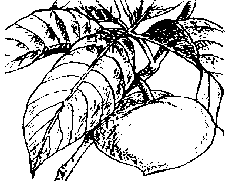

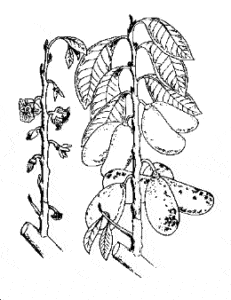



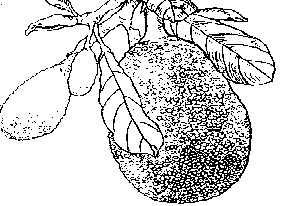

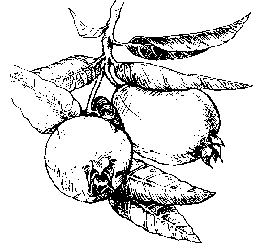



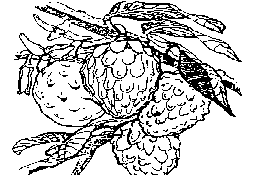




 Subscribe to the CRFG channel
Subscribe to the CRFG channel